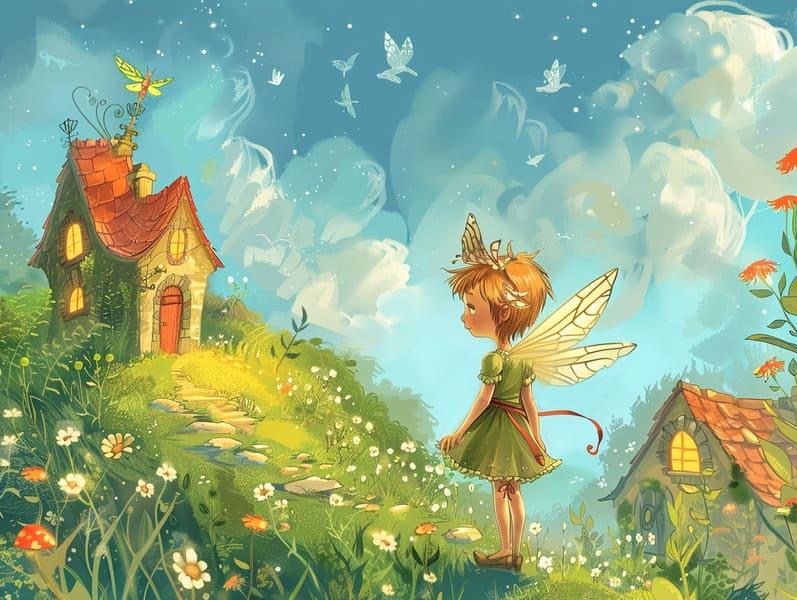
Legendary fairy tales have long histories. These tales have been transmitted from one generation to the next millennia before they were ever recorded. They emerged from a variety of traditions, including African traditions. They were initially disseminated among elders, often carrying themes and messages mirroring the societal norms and beliefs of the time.
The renowned Brothers Grimm, Jacob and Wilhelm, were among the first to gather many of these beloved tales. Their compilation, "Grimm's Folk Tales," included tales like "Cinderella," "The Story of Hansel and Gretel," and "The True Story of Snow White," which have since become pillars in the world of beloved fairy tales. Similarly, the Danish author's enchanting narratives, such as "The Story of the Little Mermaid," and "The Duckling that Could," have gained the love worldwide, guaranteeing their place in the pantheon of famous fairy tales.
Despite their age, fairy tales remain as pertinent as ever, especially as kids' bedtime tales. These delightful tales are now available in many formats, including beautifully illustrated books, whimsical animations, and internet fairy tales.
Their enduring popularity can be traced to several captivating elements:
Crucial Morals: Ancient fairy tales often teach important moral lessons. Tales like "The Wolf and the Liar" teach the merit of truthfulness, while "The Race of the Tortoise and the Hare" underline the values of steadfastness and unpretentiousness. These tales offer kids clear distinctions between ethical and unethical, building their moral compass in a subtle yet meaningful way.
Empathy and Awareness: Fairy tales frequently showcase heroes facing difficulties and adversities, motivating kids to comprehend with their struggles and celebrate their triumphs. For instance, "The Story of Beauty and the Beast" highlights the benefit of seeing beyond the surface to see the real person of a individual, advancing kindness and discernment.
Cultural Recognition: Many classic fairy tales are deeply ingrained in the cultural contexts from which they bloomed. Reading these fairy tales can provide illuminating insights into different traditions, fostering a sense of world appreciation and knowledge.
Inventiveness and Imagination: The enchanted elements in timeless fairy tales—enchanted objects—spark children’s visions. These tales bring readers to fantastical realms, engendering imaginative dreams short fairy tales for kids and a sense of astonishment that remains a lifetime.
Ancient fairy tales are not only delightful but also edifying. They work as mesmerizing tools in advancing various mind and heart abilities in children. When timeless fairy tales are spoken, they promote language development by bringing new lexicon and intricate sentence structures. This practice also promotes listening abilities and attention, as the young keep up with the story, anxious to see what happens next.
Furthermore, debating the themes and characters of classic fairy tales can sharpen evaluative skills and thinking skills. The young learn to spot patterns, foresee events, and catch on to cause and effect. These reflections also help little ones utter their thoughts and feelings, contributing to their emotional intelligence.
In today’s high-tech era, the availability of digital fairy tales has made these stories more reachable than ever. Digital sites and online apps offer large libraries of classic fairy tales that can be perused or played anytime, anywhere. Fairy tales read aloud are particularly in demand, featuring an interactive method for kids to delight in these delightful tales. Sound books and voiced videos take characters and settings to life, often joined by charming harmonies and tunes that augment the storytelling experience.
The everlasting appeal of classic fairy tales lies in their ability to shift to the present while staying true to their core messages. Contemporary modernizations of these tales often introduce more different protagonists and modern settings, making them relevant to today’s audience. However, the key lessons of daring, goodness, and impartiality remain unchanged, continuing to influence audiences of all ages.
Ancient fairy tales also offer a sense of familiarity and predictability. They put out a systematic narrative with a evident beginning, middle, and end, often closing with the resolution of conflicts and the triumph of morality over wickedness. This steadiness can be heartening for children, affording a sense of security in an dynamic world.
Old fairy tales continue to fascinate and guide new generations, maintaining their charm and significance in modern society. As kids' bedtime tales, they bequeath a perfect blend of delight and instruction, advancing moral values, empathy, and creativity. The accessibility of online storybooks and the well-received status of fairy tales read out loud assure that these timeless tales remain available to new generations.
By continuing and recounting these tales, we continue to value the rich tapestry of folklore and cultural heritage. Whether you are enjoying a colorful picture book, enjoying a virtual collection, or listening on an audio story, the charm of famous fairy tales is always within reach. These fairy tales point out of the endless presence of storytelling and its ability to bring us together across epochs and places.
Whether you are perusing a artistically illustrated book, exploring a online collection, or listening via an voice book, the grandeur of traditional fairy tales is always within reach.
These stories remind us of the lasting nature of tales and its ability to join us across centuries and lands, weaving a spell that enchants and educates alike.